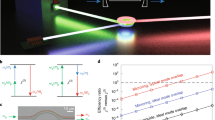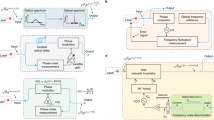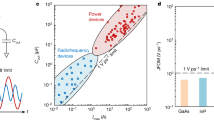Abstract
Extending beyond traditional telecom-band applications to optical interconnects1, the silicon nanophotonic integrated circuit platform also has notable advantages for use in high-performance mid-infrared optical systems operating in the 2–8 µm spectral range2,3. Such systems could find applications in industrial and environmental monitoring4, threat detection5, medical diagnostics6 and free-space communication7. Nevertheless, the advancement of chip-scale systems is impeded by the narrow-bandgap semiconductors traditionally used to detect mid-infrared photons. The cryogenic or multistage thermo-electric cooling required to suppress dark-current noise8, which is exponentially dependent on Eg/kT, can restrict the development of compact, low-power integrated mid-infrared systems. However, if the mid-infrared signals were spectrally translated to shorter wavelengths, wide-bandgap photodetectors could be used to eliminate prohibitive cooling requirements. Furthermore, such detectors typically have larger detectivity and bandwidth than their mid-infrared counterparts8. Here, we use efficient four-wave mixing in silicon nanophotonic wires9,10,11,12 to facilitate spectral translation of a signal at 2,440 nm to the telecom band at 1,620 nm, across a span of 62 THz. Furthermore, a simultaneous parametric translation gain of 19 dB can significantly boost sensitivity to weak mid-infrared signals.
This is a preview of subscription content, access via your institution
Access options
Subscribe to this journal
Receive 12 print issues and online access
$209.00 per year
only $17.42 per issue
Buy this article
- Purchase on Springer Link
- Instant access to full article PDF
Prices may be subject to local taxes which are calculated during checkout



Similar content being viewed by others
References
Green, W. M. J. et al. in SEMICON (Chiba, 2010); available at www.research.ibm.com/photonics.
Soref, R. Mid-infrared photonics in silicon and germanium. Nature Photon. 4, 495–497 (2010).
Jalali, B. et al. Prospects for silicon mid-IR Raman lasers. IEEE J. Sel. Top. Quantum Electron. 12, 1618–1627 (2006).
Willer, U., Saraji, M., Khorsandi, A., Geiser, P. & Schade, W. Near- and mid-infrared laser monitoring of industrial processes, environment and security applications. Opt. Laser Eng. 44, 699–710 (2006).
Moore, D. S. Instrumentation for trace detection of high explosives. Rev. Sci. Instrum. 75, 2499–2512 (2004).
Namjou, K., Roller, C. B. & McCann, P. J. The Breathmeter: a new laser device to analyze your health. IEEE Circ. Dev. Magazine 22–28 (2006).
Capasso, F. et al. Quantum cascade lasers: ultrahigh-speed operation, optical wireless communication, narrow linewidth, and far-infrared emission. IEEE J. Quantum Electron. 38, 511–532 (2002).
Sze, S. M. Physics of Semiconductor Devices (Wiley, 1981).
Zlatanovic, S. et al. Mid-infrared wavelength conversion in silicon waveguides using ultracompact telecom-band-derived pump source. Nature Photon. 4, 561–564 (2010).
Lau, R. K. W. et al. Continuous-wave mid-infrared frequency conversion in silicon nanowaveguides. Opt. Lett. 36, 1263–1265 (2011).
Liu, X., Osgood, J. R. M., Vlasov, Y. A. & Green, W. M. J. Mid-infrared optical parametric amplifier using silicon nanophotonic waveguides. Nature Photon. 4, 557–560 (2010).
Kuyken, B. et al. 50 dB parametric on-chip gain in silicon photonic wires. Opt. Lett. 36, 4401–4403 (2011).
Midwinter, J. E. & Warner, J. Up-conversion of near infrared to visible radiation in lithium-meta-niobate. J. Appl. Phys. 38, 519–523 (1967).
Buchter, K. D. F., Herrmann, H., Langrock, C., Fejer, M. M. & Sohler, W. All-optical Ti:PPLN wavelength conversion modules for free-space optical transmission links in the mid-infrared. Opt. Lett. 34, 470–472 (2009).
Dam, J. S., Pedersen, C. & Tidemand-Lichtenberg, P. High-resolution two-dimensional image upconversion of incoherent light. Opt. Lett. 35, 3796–3798 (2010).
Baehr-Jones, T. et al. Silicon-on-sapphire integrated waveguides for the mid-infrared. Opt. Express 18, 12127–12135 (2010).
Mashanovich, G. Z. et al. Low loss silicon waveguides for the mid-infrared. Opt. Express 19, 7112–7119 (2011).
Li, F. et al. Low propagation loss silicon-on-sapphire waveguides for the mid-infrared. Opt. Express 19, 15212–15220 (2011).
Kuyken, B. et al. in Integrated Photonics Research, paper IMB6 (Ottawa, 2011).
Spott, A., Liu, Y., Baehr-Jones, T., Ilic, R. & Hochberg, M. Silicon waveguides and ring resonators at 5.5 mm. Appl. Phys. Lett. 97, 213501 (2010).
Shankar, R., Leijssen, R., Bulu, I. & Lončar, M. Mid-infrared photonic crystal cavities in silicon. Opt. Express 19, 5579–5586 (2011).
Van Camp, M. A. et al. in Conference on Lasers and Electro-Optics, paper CTu3I.2 (San Jose, 2012).
Lin, Q., Johnson, T. J., Perahia, R., Michael, C. P. & Painter, O. J. A proposal for highly tunable optical parametric oscillation in silicon micro-resonators. Opt. Express 16, 10596–10610 (2008).
Tien, E. K. et al. Discrete parametric band conversion in silicon for mid-infrared applications. Opt. Express 18, 21981–21989 (2010).
Bristow, A. D., Rotenberg, N. & van Driel, H. M. Two-photon absorption and Kerr coefficients of silicon for 850–2200 nm. Appl. Phys. Lett. 90, 191104 (2007).
Huang, Y. et al. Electrical signal-to-noise ratio improvement in indirect detection of mid-IR signals by wavelength conversion in silicon-on-sapphire waveguides. Appl. Phys. Lett. 99, 181122 (2011).
Zlatanovic, S. et al. Mid-infrared wavelength conversion in silicon waveguides pumped by silica-fiber-based source. IEEE J. Sel. Top. Quantum Electron. 18, 612–620 (2012).
Ophir, N. et al. First demonstration of a 10-Gb/s RZ end-to-end four-wave-mixing based link at 1884 nm using silicon nanowaveguides. IEEE Photon. Technol. Lett. 24, 276–278 (2012).
Roelkens, G. et al. Integration of InP/InGaAsP photodetectors onto silicon-on-insulator waveguide circuits. Opt. Express 13, 10102–10108 (2005).
Assefa, S. et al. CMOS-integrated high-speed MSM germanium waveguide photodetector. Opt. Express 18, 4986–4999 (2010).
Acknowledgements
The authors thank the staff at imec (Leuven, Belgium) where the silicon nanophotonic waveguide devices were fabricated. The authors also thank Y.A. Vlasov (IBM Research) for many helpful and motivating discussions. B.K. acknowledges the Flemish Research Foundation (FWO) for a doctoral fellowship. This work was partially funded under the Methusalem ‘Smart Photonic Chips’ FP7-ERC-INSPECTRA and FP7-ERC-MIRACLE programmes.
Author information
Authors and Affiliations
Contributions
X.L. and B.K. performed the numerical dispersion and phase-matching design calculations. B.K., G.R. and R.B. supervised the waveguide device fabrication process. X.L. and B.K. performed the wavelength translation experiments with guidance and supervision from W.M.J.G. All authors contributed to data analysis and writing of the manuscript.
Corresponding author
Ethics declarations
Competing interests
The authors declare no competing financial interests.
Supplementary information
Supplementary information
Supplementary information (PDF 1557 kb)
Rights and permissions
About this article
Cite this article
Liu, X., Kuyken, B., Roelkens, G. et al. Bridging the mid-infrared-to-telecom gap with silicon nanophotonic spectral translation. Nature Photon 6, 667–671 (2012). https://doi.org/10.1038/nphoton.2012.221
Received:
Accepted:
Published:
Issue Date:
DOI: https://doi.org/10.1038/nphoton.2012.221
This article is cited by
-
Raman amplification at 2.2 μm in silicon core fibers with prospects for extended mid-infrared source generation
Light: Science & Applications (2023)
-
Super-broadband on-chip continuous spectral translation unlocking coherent optical communications beyond conventional telecom bands
Nature Communications (2022)
-
Broadband 200-nm second-harmonic generation in silicon in the telecom band
Light: Science & Applications (2020)
-
Efficient telecom-to-visible spectral translation through ultralow power nonlinear nanophotonics
Nature Photonics (2019)
-
Four Wave Mixing control in a photonic molecule made by silicon microring resonators
Scientific Reports (2019)



